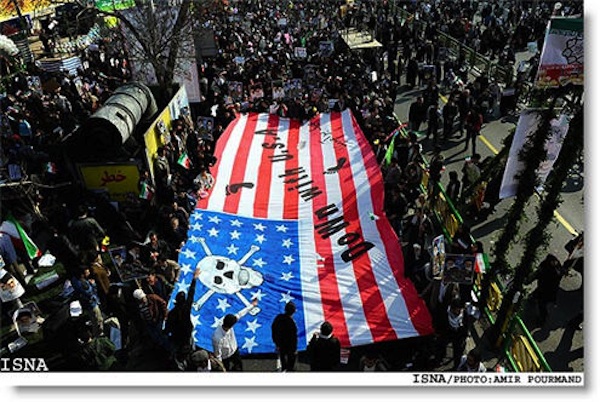

Iranians are marking the anniversary of the Islamic-led 1979 Iranian revolution with the familiar chants of “Down with the U.S.” and “Death to Israel.”
Hundreds of thousands of Iranians have gathered in Tehran for the 35th anniversary of the Islamic revolution that toppled the pro-U.S. Shah Mohammad Reza Pahlavi and brought the Islamo-facist regime to power.
State media reported similar rallies elsewhere in Iran on Tuesday.
The traditional anti-American rhetoric came despite what many in the West would like to believe was a significant political shift in Tehran, with the election last year of the so-called moderate President Hassan Rouhani, who is supposedly pursuing an open-handed policy of engagement with the West.
Iran and the six world powers came to a landmark nuclear deal in November, in which Iran vowed to cap its controversial uranium enrichment program in return for the easing of billions of dollars in sanctions by the West.
Even the president’s own party doesn’t believe the deal was smart, nor that Iran was sincere in their promise.
Meanwhile, Iran’s official news agency says the country has successfully test-fired two missiles, including a long-range ballistic missile launch, while U.S. officials mock the show of aggression by the Iranian Navy. The Navy sent what the U.S. referred to as “rust buckets” into U.S. waters to show a projection of power.
To be sure, the display of naval power is nothing significant, as the ships are truly an “afterthought” technologically speaking. But the missile launches, however, are not.
The Monday report by IRNA described the missiles as a “new generation,” but did not make clear if they were new designs or upgrades of existing ones.
It said the ballistic missile had radar-evading capabilities, but did not give a name. It said the second missile was called Bina, or “Insightful,” and was a laser-guided missile system, which could be fired from the ground or from aircraft.
Iran already has surface-to-surface missiles with a range about 2,000 kilometers (1,250 miles) capable of reaching Israel and the U.S. military bases in the region.







